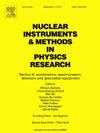CMS RPC链路系统光纤系统的设计与鉴定
IF 1.5
3区 物理与天体物理
Q3 INSTRUMENTS & INSTRUMENTATION
Nuclear Instruments & Methods in Physics Research Section A-accelerators Spectrometers Detectors and Associated Equipment
Pub Date : 2025-04-11
DOI:10.1016/j.nima.2025.170491
引用次数: 0
摘要
在LHC长时间关闭期间,将为CMS RPC室安装一个新的室外电子系统,称为链接系统。新的链接系统将把时间分辨率从目前的25纳秒提高到1.56纳秒。链路系统需要低衰减损耗的新型基础设施,光纤电缆以实现10 Gbps的高速数据传输速率。链路系统包括主链路板上用于数据传输的一个冗余通道和控制板上用于数据传输和接收的两个冗余通道。针对不同的连接器、传输距离和光纤类型,对光纤系统进行了优化,确定了所需的线缆数量、配线板的数量和位置,以及所需的功率预算。本文章由计算机程序翻译,如有差异,请以英文原文为准。
Design and qualification of the optical fiber system for the CMS RPC Link System
A new off-chamber electronics system, called the Link System, for the CMS RPC chambers will be installed during LHC Long Shutdown 3. The new Link System will improve the time resolution to 1.56 ns compared to the current value of 25 ns. The Link System requires a new infrastructure of low attenuation loss, fiber optic cables to achieve a high-speed data transmission rate of 10 Gbps. The Link System includes one redundant channel for data transmission on the Master Link Boards and two redundant channels for data transmission and reception on the Control Boards. The optical fiber system has been optimized to determine the number of cables, the number and location of patch panels, and the power budget required to support different connectors, transmission distances, and fiber types.
求助全文
通过发布文献求助,成功后即可免费获取论文全文。
去求助
来源期刊
CiteScore
3.20
自引率
21.40%
发文量
787
审稿时长
1 months
期刊介绍:
Section A of Nuclear Instruments and Methods in Physics Research publishes papers on design, manufacturing and performance of scientific instruments with an emphasis on large scale facilities. This includes the development of particle accelerators, ion sources, beam transport systems and target arrangements as well as the use of secondary phenomena such as synchrotron radiation and free electron lasers. It also includes all types of instrumentation for the detection and spectrometry of radiations from high energy processes and nuclear decays, as well as instrumentation for experiments at nuclear reactors. Specialized electronics for nuclear and other types of spectrometry as well as computerization of measurements and control systems in this area also find their place in the A section.
Theoretical as well as experimental papers are accepted.

 求助内容:
求助内容: 应助结果提醒方式:
应助结果提醒方式:


